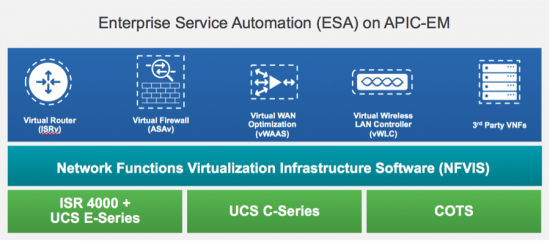































A simple and easy way to design, provision and manage the services you trust on any platform
Recall a situation where you were stuck in a traffic jam. While waiting, you see on your GPS another road paralleled to your existing one, empty with no cars at all. Didn't you wish you could cross over to that empty road? Imagine the ability to create an exit right at that instant and spot, which would enable you to bypass the traffic jam and get back to the main road ahead. That is exactly what Network Functions Virtualization (#NFV) will enable you to do in your network.
NFV will enable you to spin up a new network service in minutes to solve a business need, then take it down when it is not required anymore. As Allison Park wrote in her recent blog, NFV is not just for service providers. Enterprises can also take advantage of NFV and enjoy the same benefits such as:
I am pleased to announce that Cisco is the first vendor to bring NFV to the Enterprise with the Cisco Enterprise NFV solution, a key component of the new Cisco Digital Network Architecture. Cisco Enterprise NFV virtualizes the network and give enterprises the freedom to run services and applications on any platform. By giving you the freedom to choose, it is now simple and easy to design, provision and manage the trusted network services that are critical to your business. Enterprises can now virtualize network services at the branch similar to how many service providers hope NFV will do for their customer environments.
Some of the benefits that enterprises can gain from Enterprise NFV:
 Enterprise NFV Benefits
Enterprise NFV BenefitsCisco Enterprise NFV reduces the number of physical network devices in your enterprise and speeds up deployments of new services making it easier to manage the network services and its platform. Network engineers will waste less time learning multiple hardware devices, deploy new applications, services and branches more quickly, on-demand and centrally.
As customers make the transition from physical to virtual using software-based packaging of Cisco ONE, customers will have license portability providing up to 2X greater value over a-la-carte licensing.
Through real-time health monitoring and high availability features with software, adding or making changes to services is fast through central provisioning and does not impact other key services. A potential shorter and fewer maintenance window keeps the business running without interruptions, increases network uptime and avoids being the bottleneck.
The Components of Cisco Enterprise NFV (#EnterpriseNFV) are:
 Cisco Enterprise NFV Components
Cisco Enterprise NFV Components
Enterprise Service Automation is an application running on top of Cisco's enterprise controller, APIC-EM. It centrally orchestrates and manages network services, making it simple to deploy and manage them. ESA provides standardized site design template, zero-touch deployment, and automated monitoring of the network services, regardless of platform. It ensures optimal performance of the VNFs running on the Cisco NFVIS by monitoring and managing the health and life cycle of the services. Cisco ESA will also work on your existing ISR 4000 routers enabling you to have a mixed physical and virtual environment.
Cisco Enterprise NFV allows you to keep the services that you trust, whether they are from Cisco or a 3rdparty. With more than 40 VNFs in Cisco's portfolio, the first phase will introduce these Cisco's robust services: routing (ISRv), firewall (ASAv), application acceleration (vWAAS) and wireless LAN controllers (vWLC). License portability from the physical Cisco devices to its software counterpart is possible through Cisco ONE, providing an easy path to virtualization.
Cisco Enterprise NFV Infrastructure Software provides the flexibility and freedom of choice in deployment and platform options for the Cisco Enterprise NFV solution. By virtualizing and abstracting the network services from the underlying hardware, NFVIS allows the VNFs to be managed independently and to be provisioned dynamically. NFVIS is more than just your typical network hypervisor. NFVIS also includes service chaining, zero-touch deployment, life cycle management and programmable open APIs which are critical to maximizing the performance of your virtual network functions.
Cisco Enterprise NFV Infrastructure Software (NFVIS) can be deployed on multiple hardware options such as a compute blade (Cisco UCS E-series) integrated in the ISR 4000 series, on a standalone compute with Cisco UCS C-Series or on an off-the-shelf server. This provides the customers full flexibility to deploy network services on existing routing platforms or dedicated compute platforms.
Stay tuned for more information on Cisco NFVIS from James Sandgathe and use cases on Enterprise NFV from Kishan Ramaswamy. In the meantime, learn more via these resources:
 Hot Tags :
Virtualization
NFV
APIC
CiscoUCS
#enterprisenetworks
CiscoONE
Hot Tags :
Virtualization
NFV
APIC
CiscoUCS
#enterprisenetworks
CiscoONE